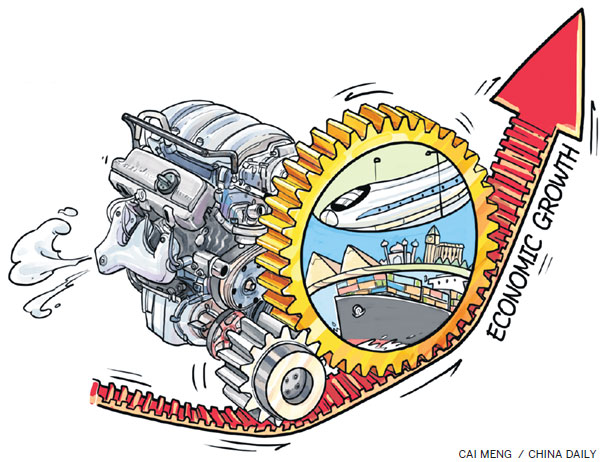Belt and Road offers tangible benefits
Editor's note: Four researchers share their views with China Daily's Cui Shoufeng on what the provinces and regions in western China should do to better integrate into and benefit from the Belt and Road Initiative, which comprises the Silk Road Economic Belt and 21st Century Maritime Silk Road. Excerpts follow:
Western region should also enjoy the fruits
The Silk Road Economic Belt could bring tangible benefits to western China and the people who live there. But that must not come at the cost of undermining the already fragile ecology in the western region. In other words, local governments have to make extra efforts to reduce the side effects of exploitation and transportation of energy, keep at bay outdated and pollution-prone industries, and focus on the modern service industry such as cultural tourism.
Building a mature, radiated economic zone on the basis of major transportation routes, too, is necessary. The lack of westward routes has added to China's cost of trading with Central Asian countries, highlighting the need for developed modern industrial clusters that pivot on provincial capitals and thrive on advanced road infrastructure.
At the forefront of the Silk Road Economic Belt is mostly the less-developed western region where talents in international trade and global market are in short supply. To boost cross-border exchanges between western China and the economies along the Belt and Road routes, the region will require sufficient intellectual support. It will also have to take into account the complexity of ethnic and religious issues in the region.
To help western China, which has more than 80 percent of the country's minority ethnic groups and the longest land border, to enjoy the fruits of the Belt and Road Initiative, the government has to further secure its western borders and ensure benign integration between different ethnic groups. And that bottom line should never be crossed to expedite transnational cooperation.
Need to strengthen 'soft' connectivity
As a growth pole in northwestern China, Shaanxi province is striving to become an inland linchpin of the Belt and Road Initiative, which has pushed landlocked western China to the forefront of the "go global" reform. Its ambition emanates from its role as a trade and logistics pivot linking China with Central Asia, even Western Europe - a technological innovation hub and a cultural tourism center.
The international freight train Chang'an, which made its maiden run to Central Asia in November 2013, now travels up to Rotterdam, a seaport in the Netherlands.

Home to a number of leading universities and research institutes, Shaanxi has a versatile, complete industrial system, whose aerospace, energy and telecommunications sectors are well known nationwide. That allows the province to work closely with some resource-rich Central Asian countries in terms of exploration of resources.
Shaanxi is also home to a slew of cultural heritages related to the ancient Silk Road, giving it a unique advantage in boosting cultural, academic and people-to-people exchanges with Central Asian communities.
But since the province does not have enough scholars who specialize in South Asian and Southeast Asian studies, particularly with regard to issues related to customs and resources, in the economies along the Belt and Road routes, enterprises that have managed to "go global" often struggle to proceed with their projects for the lack of knowledge about local laws and regulations, as well as the endorsement of Shaanxi authorities. Besides, not many Shaanxi residents choose Central Asian destinations to spend their holidays. So, extra efforts must be made to strengthen the province's "soft" connectivity with the economies along the Belt and Road routes.
Onus on Sichuan to seize opportunity
Southwest China's Sichuan province does not share borders with any country nor does it have a seacoast. Notwithstanding its unfavorable geographical location, the province, particularly the provincial capital of Chengdu, has all it takes to play the leading role in helping China realize the goals of the Belt and Road Initiative.

The westbound Chengdu-Europe Express Railway is expected to include three major routes - one to the Polish city of Lodz, one to Istanbul in Turkey, and one to Russia. It is still the most used express railway route to trade with Europe, and transporting goods by railways takes less time than by ships. Also, neighboring Yunnan province and the Guangxi Zhuang autonomous region can help Sichuan reach the Southeast Asian market through their land and sea routes, respectively.
On the economic front, Sichuan's GDP reached about 3.27 trillion yuan in 2016, and Chengdu Financial City has the potential to become a regional financial hub. Instead of transferring its production overcapacity to the economies along the Belt and Road routes, Sichuan aims to export its flagship products such as machinery and electronics as well as its infrastructural expertise to Central Asian and Southeast Asian economies, which are exactly what many of the regions' economies want.
From a historic and realistic point of view, Sichuan has a responsibility to help western China seize the development opportunity arising out of the Belt and Road Initiative. A priority for Sichuan is to establish an effective communication mechanism among the 12 western provincial-level regions, which sometimes struggle to make the best use of their advantages and developmental focuses despite their diverse yet generally complementary nature.
For Guangxi, maritime routes must be priority

During a recent inspection tour of South China's Guangxi Zhuang autonomous region, President Xi Jinping said he expected the coastal region to play a bigger role in the implementation of the Belt and Road projects by exploiting its advantages in shipping. For that to happen, Guangxi has to deepen its economic relations with the member states of the Association of Southeast Asian Nations while optimizing its "opening-up" strategy.
In the past year alone, the trade between Guangxi and the Belt and Road economies was worth 200 billion yuan ($29 billion), or more than 63 percent of the region's cross-border trade. Guangxi enterprises also invested more than $871 million in the economies along the two routes during the same period, which was about 54 percent of its total overseas investment.
The success is laudable, but there is still huge potential to be untapped. About 70 percent of Guangxi's trade exchanges with ASEAN economies are with Vietnam, which shares a land border with the autonomous region. It is thus clear Guangxi has not realized the full potential of its maritime connectivity with Southeast Asia.
Measures should be taken to ensure that Qinzhou, Guangxi's largest container port that now has 15 international trade routes, opens up new sea routes connecting more destinations in Southeast Asia. The China-Malaysia Qinzhou Industrial Park and the Malaysia-China Kuantan Industrial Park mark a key step toward diversified, deepened cooperation between Guangxi and the ASEAN community. And increasing the "soft" connectivity - through the use of big data, concerted policymaking and cultural exchanges - should top Guangxi's future development agenda.

(China Daily USA 05/09/2017 page12)
















